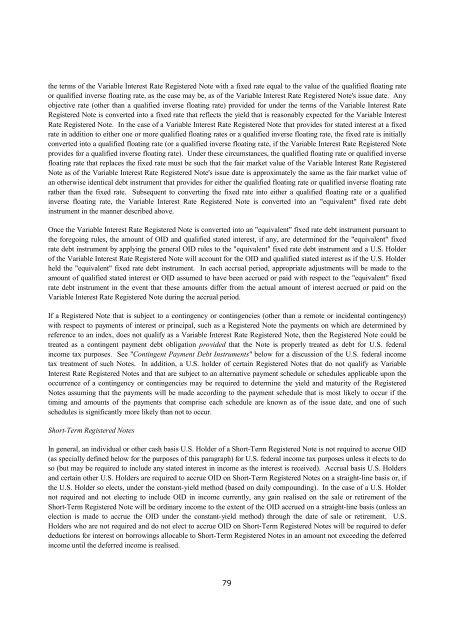JPMORGAN CHASE & CO. - Irish Stock Exchange
JPMORGAN CHASE & CO. - Irish Stock Exchange
JPMORGAN CHASE & CO. - Irish Stock Exchange
You also want an ePaper? Increase the reach of your titles
YUMPU automatically turns print PDFs into web optimized ePapers that Google loves.
the terms of the Variable Interest Rate Registered Note with a fixed rate equal to the value of the qualified floating rate<br />
or qualified inverse floating rate, as the case may be, as of the Variable Interest Rate Registered Note's issue date. Any<br />
objective rate (other than a qualified inverse floating rate) provided for under the terms of the Variable Interest Rate<br />
Registered Note is converted into a fixed rate that reflects the yield that is reasonably expected for the Variable Interest<br />
Rate Registered Note. In the case of a Variable Interest Rate Registered Note that provides for stated interest at a fixed<br />
rate in addition to either one or more qualified floating rates or a qualified inverse floating rate, the fixed rate is initially<br />
converted into a qualified floating rate (or a qualified inverse floating rate, if the Variable Interest Rate Registered Note<br />
provides for a qualified inverse floating rate). Under these circumstances, the qualified floating rate or qualified inverse<br />
floating rate that replaces the fixed rate must be such that the fair market value of the Variable Interest Rate Registered<br />
Note as of the Variable Interest Rate Registered Note's issue date is approximately the same as the fair market value of<br />
an otherwise identical debt instrument that provides for either the qualified floating rate or qualified inverse floating rate<br />
rather than the fixed rate. Subsequent to converting the fixed rate into either a qualified floating rate or a qualified<br />
inverse floating rate, the Variable Interest Rate Registered Note is converted into an "equivalent" fixed rate debt<br />
instrument in the manner described above.<br />
Once the Variable Interest Rate Registered Note is converted into an "equivalent" fixed rate debt instrument pursuant to<br />
the foregoing rules, the amount of OID and qualified stated interest, if any, are determined for the "equivalent" fixed<br />
rate debt instrument by applying the general OID rules to the "equivalent" fixed rate debt instrument and a U.S. Holder<br />
of the Variable Interest Rate Registered Note will account for the OID and qualified stated interest as if the U.S. Holder<br />
held the "equivalent" fixed rate debt instrument. In each accrual period, appropriate adjustments will be made to the<br />
amount of qualified stated interest or OID assumed to have been accrued or paid with respect to the "equivalent" fixed<br />
rate debt instrument in the event that these amounts differ from the actual amount of interest accrued or paid on the<br />
Variable Interest Rate Registered Note during the accrual period.<br />
If a Registered Note that is subject to a contingency or contingencies (other than a remote or incidental contingency)<br />
with respect to payments of interest or principal, such as a Registered Note the payments on which are determined by<br />
reference to an index, does not qualify as a Variable Interest Rate Registered Note, then the Registered Note could be<br />
treated as a contingent payment debt obligation provided that the Note is properly treated as debt for U.S. federal<br />
income tax purposes. See "Contingent Payment Debt Instruments" below for a discussion of the U.S. federal income<br />
tax treatment of such Notes. In addition, a U.S. holder of certain Registered Notes that do not qualify as Variable<br />
Interest Rate Registered Notes and that are subject to an alternative payment schedule or schedules applicable upon the<br />
occurrence of a contingency or contingencies may be required to determine the yield and maturity of the Registered<br />
Notes assuming that the payments will be made according to the payment schedule that is most likely to occur if the<br />
timing and amounts of the payments that comprise each schedule are known as of the issue date, and one of such<br />
schedules is significantly more likely than not to occur.<br />
Short-Term Registered Notes<br />
In general, an individual or other cash basis U.S. Holder of a Short-Term Registered Note is not required to accrue OID<br />
(as specially defined below for the purposes of this paragraph) for U.S. federal income tax purposes unless it elects to do<br />
so (but may be required to include any stated interest in income as the interest is received). Accrual basis U.S. Holders<br />
and certain other U.S. Holders are required to accrue OID on Short-Term Registered Notes on a straight-line basis or, if<br />
the U.S. Holder so elects, under the constant-yield method (based on daily compounding). In the case of a U.S. Holder<br />
not required and not electing to include OID in income currently, any gain realised on the sale or retirement of the<br />
Short-Term Registered Note will be ordinary income to the extent of the OID accrued on a straight-line basis (unless an<br />
election is made to accrue the OID under the constant-yield method) through the date of sale or retirement. U.S.<br />
Holders who are not required and do not elect to accrue OID on Short-Term Registered Notes will be required to defer<br />
deductions for interest on borrowings allocable to Short-Term Registered Notes in an amount not exceeding the deferred<br />
income until the deferred income is realised.<br />
79
















